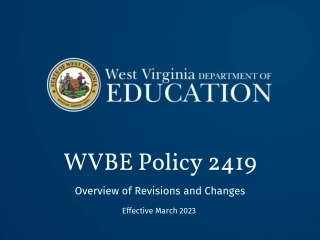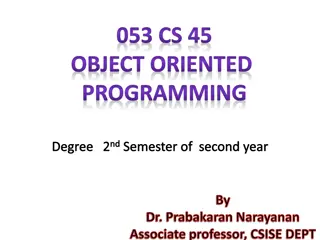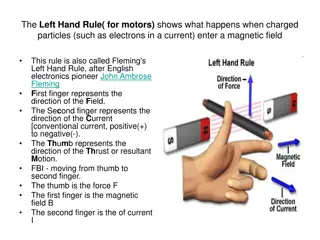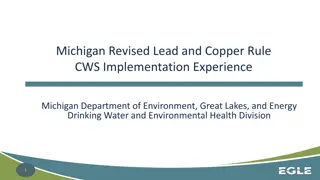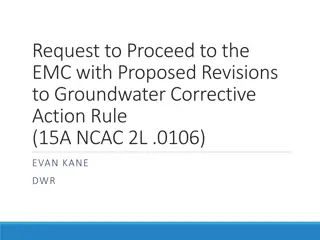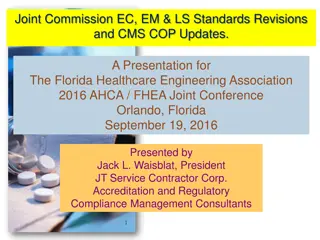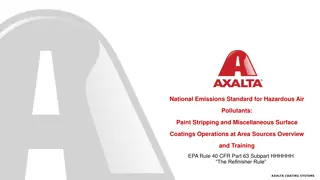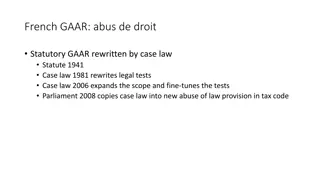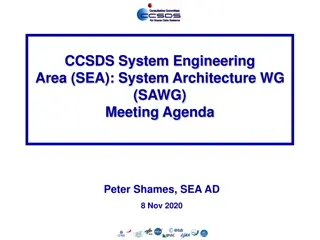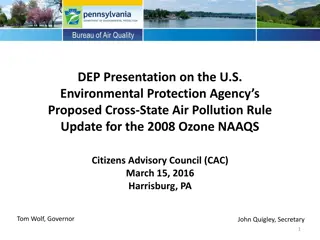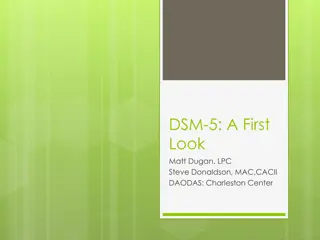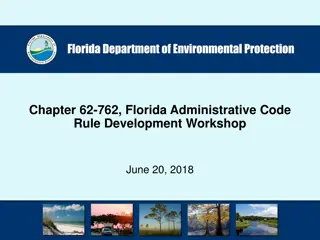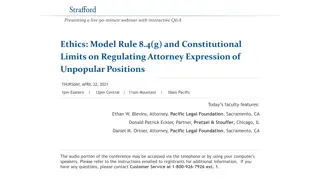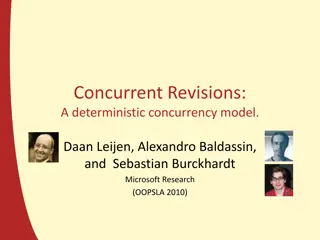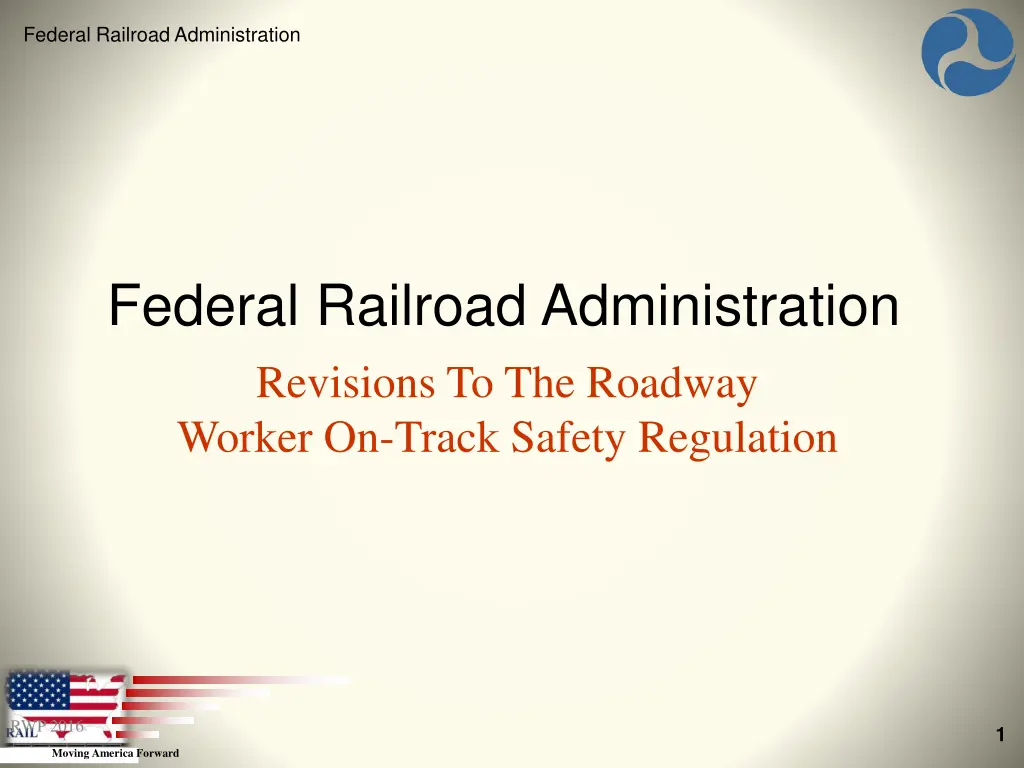
Federal Railroad Administration Revisions to Roadway Worker On-Track Safety Regulation RWP 2016.1
"Get insights into the Federal Railroad Administration's revisions to the Roadway Worker On-Track Safety Regulation RWP 2016.1 for moving America's railway systems forward. Understand the new definitions, changes, and definitions regarding control points, effective securing devices, and more."
Download Presentation

Please find below an Image/Link to download the presentation.
The content on the website is provided AS IS for your information and personal use only. It may not be sold, licensed, or shared on other websites without obtaining consent from the author. If you encounter any issues during the download, it is possible that the publisher has removed the file from their server.
You are allowed to download the files provided on this website for personal or commercial use, subject to the condition that they are used lawfully. All files are the property of their respective owners.
The content on the website is provided AS IS for your information and personal use only. It may not be sold, licensed, or shared on other websites without obtaining consent from the author.
E N D
Presentation Transcript
Federal Railroad Administration Federal Railroad Administration Revisions To The Roadway Worker On-Track Safety Regulation RWP 2016 1 Moving America Forward
Presentation Notes Federal Railroad Administration This presentation is intended to provide guidance in broad terms. It is not intended to serve as a complete explanation of the Revisions to the RWP regulations or as a substitute for application of the regulations to specific facts. The Track Division Technical Bulletins and/or Compliance Manual provides additional guidance regarding the regulation. Each section/paragraph shown on a presentation slide is the regulatory text with appropriate modifications indicated. User must consult the regulation & preamble in its entirety when applying the regulation. This presentation does not provide any information about specific procedures on any railroad, nor may it be used to qualify any person. Roadway workers are required to be trained on the specific rules and procedures of each railroad upon which they are to perform RW Moving America Forward duties as defined by this regulation. 2
Federal Railroad Administration Learning Objectives 1. Understand the new definitions and changes to Part 214, Subpart C. 2. Apply the new changes to Part 214, Subpart C in a practical real world environment. 3 Moving America Forward
Federal Railroad Administration 214.7 Definitions Control Point - means a location where signals and/or other functions of a traffic control system are controlled from the control machine. 4 Moving America Forward
Federal Railroad Administration 214.7 Definitions Effective Securing Device - means a vandal and tamper resistant lock, keyed for application and removal only by the roadway worker(s) for whom the protection is provided. In the absence of a lock, it is acceptable to use a spike driven firmly into a switch tie or a switch point clamp to prevent the use of a manually operated switch. It is also acceptable to use portable derails secured with specifically designed metal wedges. Securing devices without a specially keyed lock shall be designed in such a manner that they require railroad track tools for installation and removal and the operating rules of the railroad must prohibit removal by employees other than the class, craft, or group of employees for whom the protection is being provided. Regardless of the type of securing device, the throwing handle or hasp of the switch or derail shall be uniquely tagged. If there is no throwing handle, the securing device shall be tagged. 5 Moving America Forward
Federal Railroad Administration 214.7 Definitions Interlocking, Manual - means an arrangement of signals and signal appliances operated from an interlocking machine and so interconnected by means of mechanical and/or electric locking that their movements must succeed each other in proper sequence, train movements over all routes being governed by signal indication. 6 Moving America Forward
Federal Railroad Administration 214.7 Definitions Maximum Authorized Speed - means the highest speed permitted for the movement of trains permanently established by timetable/special instructions, general order, or track bulletin. 7 Moving America Forward
Federal Railroad Administration 214.7 Definitions On-Track Safety Manual - means the entire set of on-track safety rules and instructions maintained together in one manual designed to prevent roadway workers from being struck by trains or other on-track equipment. These instructions include operating rules and other procedures concerning on-track safety protection and on-track safety measures. 8 Moving America Forward
Federal Railroad Administration 214.7 Definitions Roadway Worker In Charge - means a roadway worker who is qualified under 214.353 to establish on-track safety for roadway work groups, and lone workers qualified under 214.347 to establish on-track safety for themselves. 9 Moving America Forward
Federal Railroad Administration 214.7 Definitions Roadway Maintenance Machines Equipped With A Crane - means any roadway maintenance machine equipped with a crane or boom that can hoist, lower, and horizontally move a suspended load. Note: This definition (noted in red above) is reflective of Part 243 effective January 1, 2015 and not contained in the Revision to RWP Rule. 10 Moving America Forward
Federal Railroad Administration 214.7 Definitions Watchman/lookout - means an employee who has been annually trained and qualified to provide warning to roadway workers of approaching trains or on-track equipment. Watchmen/lookouts shall be properly equipped to provide visual and auditory warning such as whistle, air horn, white disk, red flag, lantern, fusee. A watchman/lookout s sole duty is to look out for approaching trains/on-track equipment and provide at least fifteen seconds advanced warning to employees before arrival of trains/on-track equipment. 11 Moving America Forward
Federal Railroad Administration 214.113 Head Protection a) Railroad bridge workers working in areas where there is a possible danger of head injury from impact, or from falling or flying objects, or from electrical shock and burns, shall be provided and shall wear protective helmets. b) Helmets required by this section shall conform to the requirements of 29 CFR 1910.135(b), as established by the U.S. Department of Labor, Occupational Safety and Health Administration. 12 Moving America Forward
Federal Railroad Administration 214.115 Foot Protection a) The railroad or railroad contractor shall require railroad bridge workers to wear foot protection equipment when potential foot injury may result from impact, falling or flying objects, electrical shock or burns, or other hazardous condition. b) Foot protection equipment required by this section shall conform to the requirements of 29 CFR 1910.136(b), as established by the U.S. Department of Labor, Occupational Safety and Health Administration. . 13 Moving America Forward
Federal Railroad Administration 214.117 Eye and Face Protection a) Railroad bridge workers shall be provided and shall wear eye and face protection equipment when potential eye or face injury may result from physical, chemical, or radiant agents. b) Eye and face protection equipment required by this section shall conform to the requirements of 29 CFR 1910.133(b), as established by the U.S. Department of Labor, Occupational Safety and Health Administration.. 14 Moving America Forward
Federal Railroad Administration 214.117 Eye and Face Protection Cont d Face and eye protection equipment required by this section shall be kept clean and in good repair. Use of equipment with structural or optical defects is prohibited. Railroad bridge workers whose vision requires the use of corrective lenses, when required by this section to wear eye protection, shall be protected by goggles or spectacles of one of the following types: i. Spectacles whose protective lenses provide optical correction the, frame of which includes shielding against objects reaching the wearer's eyes around the lenses; ii. Goggles that can be worn over corrective lenses without disturbing the adjustment of the lenses; or iii. Goggles that incorporate corrective lenses mounted behind the protective lenses. c) d) 15 Moving America Forward
Federal Railroad Administration 214.301 Purpose and Scope The purpose of this subpart is to prevent accidents and casualties caused by moving railroad cars, locomotives or roadway maintenance machines striking roadway workers or roadway maintenance machines. This subpart prescribes minimum safety standards for roadway workers. Each railroad and railroad contractor may prescribe additional or more stringent operating rules, safety rules, and other special instructions that are consistent with this subpart. This subpart prescribes safety standards related to the movement of roadway maintenance machines where such movements affect the safety of roadway workers. Except as provided for in 214.320 of this part, this subpart does not otherwise affect movements of roadway maintenance machines that are conducted under the authority of a train dispatcher, a control operator, or the operating rules of the railroad. a) b) c) 16 Moving America Forward
Federal Railroad Administration 214.302 Information Collection Requirements and 214.305 Compliance Dates Remove and reserve 214.302. Remove and reserve 214.305. 17 Moving America Forward
Federal Railroad Administration 214.307 On-Track Safety Programs Each railroad subject to this part shall maintain and have in effect an on-track safety program which complies with the requirements of this subpart. New railroads must have an on-track safety program in effect by the date on which operations commence. The on-track safety program shall be retained at a railroad s system headquarters and division headquarters, and shall be made available to representatives of the FRA for inspection and copying during normal business hours. Each railroad to which this part applies is authorized to retain its program by electronic recordkeeping in accordance with 217.9(g) and 217.11(c) of this subchapter. Each railroad shall notify, in writing, the Associate Administrator for Safety, Federal Railroad Administration, RRS-15, 1200 New Jersey Avenue, SE., Washington, DC 20590, not less than one month before its on-track safety program becomes effective. The notification shall include the effective date of the program and the name, title, address and telephone number of the primary person to be contacted with regard to review of the program. This notification procedure shall also apply to subsequent changes to a railroad's on-track safety program. a) b) 18 Moving America Forward
Federal Railroad Administration 214.307 On-Track Safety Programs Cont d A railroad's on-track safety program will take effect by the established compliance dates in 214.305, without regard to the date of review or approval by the Federal Railroad Administration. Changes to a railroad's program will take effect on dates established by each railroad without regard to the date of review and approval by the Federal Railroad Administration. c) 19 Moving America Forward
Federal Railroad Administration 214.307 On-Track Safety Programs Cont d c. Upon review of a railroad s on-track safety program, the FRA Associate Administrator for Railroad Safety/Chief Safety Officer may, for cause stated, disapprove the program. Notification of such disapproval shall be made in writing and specify the basis for the disapproval decision. If the Associate Administrator for Railroad Safety/Chief Safety Officer disapproves the program, The railroad has 35 days from the date of the written notification of such disapproval to: i. Amend its program and submit it to the Associate Administrator for Railroad Safety/Chief Safety Officer for approval; or ii. Provide a written response in support of its program to the Associate Administrator for Railroad Safety/Chief Safety Officer. 2) FRA s Associate Administrator for Railroad Safety and Chief Safety Officer will subsequently issue a written decision either approving or disapproving the railroad s program. 3) Failure to submit to FRA an amended program or provide a written response in accordance with this paragraph will be considered a failure to implement an on-track safety program under this subpart. 1) 20 Moving America Forward
Federal Railroad Administration 214.309 On-Track Safety Manual The applicable on-track safety manual (as defined by 214.7) shall be readily available to all roadway workers. Each roadway worker in charge responsible for the on-track safety of others, and each lone worker, shall be provided with and shall maintain a copy of the on-track safety manual. b) When it is impracticable for the on-track safety manual to be readily available to a lone worker, the employer shall establish provisions for such worker to have alternative access to the information in the manual. Changes to the on-track safety manual may be temporarily published in bulletins or notices. Such publications shall be retained along with the on-track safety manual until fully incorporated into the manual. a) c) 21 Moving America Forward
Federal Railroad Administration 214.315 Supervision and Communication a)When an employer assigns a duty to a roadway worker that calls for that employee to foul a track, the employer shall provide the employee with an on-track safety job briefing that, at a minimum, includes the following: 1) Information on the means by which on-track safety is to be provided for each track identified to be fouled; 2) Instruction on each on-track safety procedure to be followed; 3) Information about any adjacent tracks, on-track safety for such tracks, if required by this subpart or deemed necessary by the roadway worker in charge, and identification of any roadway maintenance machines that will foul such tracks; and 4) A discussion of the nature of the work to be performed and the characteristics of the work location to ensure compliance with this subpart; and 5) Information on the accessibility of the roadway worker in charge and alternative procedures in the event the roadway worker in charge is no longer accessible to the members of the roadway work group. 22 Moving America Forward
Federal Railroad Administration 214.315 Supervision and Communication A job briefing for on-track safety shall be deemed complete only after the roadway worker(s) has acknowledged understanding of the on-track safety procedures and instructions presented. Every roadway work group whose duties require fouling a track shall have one roadway worker in charge designated by the employer to provide on-track safety for all members of the group. The designated person shall be qualified under the rules of the railroad that conducts train operations on those tracks to provide the protection necessary for on- track safety of each individual in the group. The responsible person may be designated generally, or specifically for a particular work situation. b) c) 23 Moving America Forward
Federal Railroad Administration 214.315 Supervision and Communication Before any member of a roadway work group fouls a track, the roadway worker in charge designated under paragraph (c) of this section shall inform each roadway worker of the on-track safety procedures to be used and followed during the performance of the work at that time and location. Each roadway worker shall again be so informed at any time the on-track safety procedures change during the work period. Such information shall be given to all roadway workers affected before the change is effective, except in cases of emergency. Any roadway workers who, because of an emergency, cannot be notified in advance shall be immediately warned to leave the fouling space and shall not return to the fouling space until on-track safety is re-established. Each lone worker shall communicate at the beginning of each duty period with a supervisor or another designated employee to receive an on-track safety job briefing and to advise of his or her planned itinerary and the procedures that he or she intends to use for on-track safety. When communication channels are disabled, the job briefing shall be conducted as soon as possible after the beginning of the work period when communications are restored. d) e) 24 Moving America Forward
Federal Railroad Administration 214.317 On-Track Safety Procedures, Generally a) Each employer subject to the provisions of this part shall provide on-track safety for roadway workers by adopting a program that contains specific rules for protecting roadway workers that comply with the provisions of 214.319 through 214.337 of this part. b) Roadway workers may walk across any track provided that they can safely be across and clear of the track before a train or other on-track equipment would arrive at the crossing point under the following circumstances: 1) Employers shall adopt, and roadway workers shall comply with, applicable railroad safety rules governing how to determine that it is safe to cross the track before starting across; 2) Roadway workers shall move directly and promptly across the track; and 3) On-track safety protection is in place for all roadway workers who are actually engaged in work, including inspection, construction, maintenance or repair, and extending to carrying tools or material that restricts motion, impairs sight or hearing, or prevents an employee from detecting and moving rapidly away from an approaching train or other on-track equipment. 25 Moving America Forward
Federal Railroad Administration 214.317 On-Track Safety Procedures, Generally c) On non-controlled track, on-track roadway maintenance machines engaged in weed spraying or snow removal may proceed under the provisions of 214.301(c), under the following conditions: 1) Each railroad shall establish and comply with an operating procedure for on-track snow removal and weed spray equipment to ensure that: i. All on-track movements in the affected area are informed of such operations; ii. All on-track movements shall operate at restricted speed as defined in 214.7, except on other than yard tracks and yard switching leads, where all on-track movements shall operate prepared to stop within one-half the range of vision but not exceeding 25 mph; iii.A means for communication between the on-track equipment and other on-track movements is provided; and iv. Remotely controlled hump yard facility operations are not in effect, and kicking of cars is prohibited unless agreed to by the roadway worker in charge. 2) Roadway workers engaged in such snow removal or weed spraying operations subject to this section shall retain an absolute right to use the provisions of 214.327 (inaccessible track). 26 Moving America Forward
Federal Railroad Administration 214.317 On-Track Safety Procedures, Generally c) On non-controlled track, on-track roadway maintenance machines engaged in weed spraying or snow removal may proceed under the provisions of 214.301(c), under the following conditions: 3) Roadway workers assigned to work with this equipment may line switches (or derails operated via a switch stand) for the machine s movement but shall not engage in any roadway work activity unless protected by another form of on-track safety. 4) Each roadway maintenance machine engaged in snow removal or weed spraying under this provision shall be equipped with and utilize: i. An operative 360-degree intermittent warning light or beacon; ii. Work lights, if the machine is operated during the period between one-half hour after sunset and one-half hour before sunrise or in dark areas such as tunnels, unless equivalent lighting is otherwise provided; iii.An illumination device, such as a headlight, capable of illuminating obstructions on the track ahead in the direction of travel for a distance of 300 feet under normal weather and atmospheric conditions; iv. A brake light activated by the application of the machine braking system, and designed to be visible for a distance of 300 feet under normal weather and atmospheric conditions; and v. A rearward viewing device, such as a rearview mirror. 27 Moving America Forward
Federal Railroad Administration 214.317 On-Track Safety Procedures, Generally d) Tunnel niches or clearing bays in existence prior to April 1, 2017 that are designed to permit roadway workers to occupy a place of safety when trains or other on- track equipment pass the niche or clearing bay, but which may be less than four feet from the field side of the nearest rail, may continue to be used as a place of safety provided: 1) Such niches or clearing bays are visually inspected by the roadway work group prior or lone worker to making the determination that the niche or clearing bay is suitable for use as a place of safety; 2) There is adequate sight distance to permit the roadway worker or lone worker to occupy the place of safety in the niche or clearing bay at least 15 seconds prior to the arrival of a train or other on-track equipment at the work location in accordance with 214.329 and 337; and 3) The roadway worker in charge or lone worker shall have the absolute right to designate a place of safety as a location other than that of a tunnel niche or clearing bay described by this paragraph, or to establish working limits. 28 Moving America Forward
Federal Railroad Administration 214.318 Locomotive Servicing and Car Shop Repair Track Areas In lieu of the requirements of this subpart, workers (as defined by 218.5 of this chapter) within the limits of locomotive servicing and car shop repair track areas (as both defined by 218.5 of this chapter) may utilize procedures established by a railroad in accordance with subpart B of part 218 of this chapter (Blue Signal Protection) to perform duties incidental to inspecting, testing, servicing, or repairing rolling equipment when those incidental duties involve fouling a track that is protected by Blue Signal Protection. A railroad utilizing Blue Signal Protection in lieu of the requirements of this subpart must have rules in effect governing the applicability of those protections to the incidental duties being performed. Paragraph (a) of this section applies to employees of a contractor to a railroad if such incidental duties are performed under the supervision of a railroad employee qualified (as defined by 217.4 of this chapter) on the railroad s rules and procedures implementing the Blue Signal a) b) 29 Moving America Forward Protection requirements.
Federal Railroad Administration 214.318 Locomotive Servicing and Car Shop Repair Track Areas Any work performed within the limits of a locomotive servicing and car shop repair track area with the potential of fouling a track which requires a person qualified under 213.7 of this chapter to be present to inspect or supervise such work must be performed in accordance with the requirements of this subpart. Note the following definitions: Car shop repair track area means one or more tracks within an area in which the testing, servicing, repair, inspection, or rebuilding of railroad rolling equipment is under the exclusive control of mechanical department personnel. ( 218.5 Definitions) Locomotive servicing track area means one or more tracks, within an area in which the testing, servicing, repair, inspection, or rebuilding of locomotives is under the exclusive control of mechanical department personnel. ( 218.5 Definitions) c) 30 Moving America Forward
Federal Railroad Administration 214.319 Working Limits, Generally Working limits established on controlled track shall conform to the provisions of 214.321 Exclusive track occupancy, or 214.323 Foul time, or 214.325 Train coordination. Working limits established on non-controlled track shall conform to the provision of 214.327 Inaccessible track. Working limits established under any procedure shall, in addition, conform to the following provisions: 1) (a) Only a roadway worker in charge who is qualified in accordance with 214.353 of this part shall establish or have control over working limits for the purpose of establishing on-track safety. 2) (b) Only one roadway worker in charge who is qualified in accordance with 214.353 of this part shall have control over working limits on any one segment of track. 3) (c) All affected roadway workers shall be notified before working limits are released for the operation of trains. Working limits shall not be released until all affected roadway workers have either left the track or have been afforded on-track safety through train approach warning in accordance with 214.329 of this subpart. a) 31 Moving America Forward
Federal Railroad Administration 214.319 Working Limits, Generally Working limits established on controlled track shall conform to the provisions of 214.321 Exclusive track occupancy, or 214.323 Foul time, or 214.325 Train coordination. Working limits established on non-controlled track shall conform to the provision of 214.327 Inaccessible track. Each Class I or Class II railroad or each railroad providing regularly scheduled intercity or commuter rail passenger transportation that utilizes controlled track working limits as a form of on-track safety (under 214.321 214.323) in signalized territory shall: 1) By July 1, 2017, evaluate its on-track safety program and identify an appropriate method(s) of providing redundant signal protections for roadway work groups who depend on a train dispatcher or control operator to provide signal protection in establishing controlled track working limits. For purposes of this section, redundant signal protections means risk mitigation measures or safety redundancies adopted to ensure the proper establishment and maintenance of signal protections for controlled track working limits until such working limits are released by the roadway worker in charge. Appropriate redundant protections could include the use of various risk mitigation measures (or a combination of risk mitigation measures) such as technology, training, supervision, or operating-based procedures; or could include use of redundant signal protection, such as shunting, designed to prevent signal system-related incursions into established controlled track working limits; and b) 32 Moving America Forward
Federal Railroad Administration 214.319 Working Limits, Generally Working limits established on controlled track shall conform to the provisions of 214.321 Exclusive track occupancy, or 214.323 Foul time, or 214.325 Train coordination. Working limits established on non-controlled track shall conform to the provision of 214.327 Inaccessible track. 2) By January 1, 2018, specifically identify, implement, and comply with the method(s) of providing redundant protections in its on-track safety program. Upon a railroad s request, FRA will consider an exemption from the requirements of paragraph (b) of this section for each segment of track(s) for which operations are governed by a positive train control system under part 236, subpart I of this chapter. A request for approval to exempt a segment of track must be submitted in writing to the FRA Associate Administrator for Railroad Safety and Chief Safety Officer. The FRA Associate Administrator for Railroad Safety and Chief Safety Officer will review a railroad s submission and will notify a railroad of its approval or disapproval in writing within 90 days of FRA s receipt of a railroad s written request, and shall specify the basis for any disapproval decision. c) 33 Moving America Forward
Federal Railroad Administration 214.320 Roadway Maintenance Machine Movements Over Signalized Non-controlled Track. Working limits must be established for roadway maintenance machine movements on non-controlled track equipped with automatic block signal systems over which trains are permitted to exceed restricted speed (for purposes of this section, on-track movements prepared to stop within on-half the range of vision but not exceeding 25 mph). This section applies, unless the railroad s operating rules protect the movements of roadway maintenance machines in a manner equivalent to that provided for by limiting all train and locomotive movements to restricted speed, and such equivalent level of protection is first approved in writing by FRA s Associate Administrator for Railroad Safety and Chief Safety Officer. 34 Moving America Forward
Federal Railroad Administration 214.321 Exclusive Track Occupancy. Working limits established on controlled track through the use of exclusive track occupancy procedures shall comply with the following requirements: The track within working limits shall be placed under the control of one roadway worker in charge by either: 1) Authority issued to the roadway worker in charge by the train dispatcher or control operator who controls train movements on that track, 2) Flagmen stationed at each entrance to the track within working limits and instructed by the roadway worker in charge to permit the movement of trains and equipment into the working limits only as permitted by the roadway worker in charge, or 3) The roadway worker in charge causing fixed signals at each entrance to the working limits to display an aspect indicating Stop. a) 35 Moving America Forward
Federal Railroad Administration 214.321 Exclusive Track Occupancy. b) An authority for exclusive track occupancy given to the roadway worker in charge of the working limits shall be transmitted on a written or printed document directly, by relay through a designated employee, in a data transmission, or by oral communication, to the roadway worker in charge by the train dispatcher or control operator in charge of the track. 1) Where authority for exclusive track occupancy is transmitted orally, the authority shall be written as received by the roadway worker in charge and repeated to the issuing employee for verification. 2) The roadway worker in charge of the working limits shall maintain possession of the written or printed authority for exclusive track occupancy while the authority for the working limits is in effect. A data transmission of an authority displayed on an electronic screen may be used as a substitute for a written or printed document required under this paragraph. Electronic displays of authority shall comply with the requirements of 214.322. 3) The train dispatcher or control operator in charge of the track shall make a written or electronic record of all authorities issued to establish exclusive track occupancy. 4) An authority shall specify a unique roadway work group number, an employee name, or a unique identifier. A railroad shall adopt procedures that require precise communication between trains and other on-track equipment and the roadway worker in charge or lone worker controlling the working limits in accordance with 214.319. The procedures may permit communications to be made directly between a train or other on-track equipment and a roadway worker in charge or lone worker, or through a train dispatcher or control operator. 36 Moving America Forward
Federal Railroad Administration 214.321 Exclusive Track Occupancy. c) The extent of working limits established through exclusive track occupancy shall be defined by one of the following physical features clearly identifiable to a locomotive engineer or other person operating a train or railroad equipment: 1) A flagman with instructions and capability to hold all trains and equipment clear of the working limits; 2) A fixed signal that displays an aspect indicating Stop ; 3) A station shown in the time-table, and identified by name with a sign, beyond which train movement is prohibited by train movement authority or the provisions of a direct train control system. 4) A clearly identifiable milepost sign beyond which train movement is prohibited by train movement authority or the provisions of a direct train control system; or 5) A clearly identifiable physical location prescribed by the operating rules of the railroad that trains may not pass without proper authority. 37 Moving America Forward
Federal Railroad Administration 214.321 Exclusive Track Occupancy. d) Movements of trains and roadway maintenance machines within working limits established through exclusive track occupancy shall be made only under the direction of the roadway worker in charge having control of the working limits. Such movements shall be at restricted speed unless a higher authorized speed has been specifically authorized by the roadway worker in charge of the working limits. Working limits established by exclusive track occupancy authority may occur behind designated trains moving through the same limits in accordance with the following provisions: 1) The authority establishing working limits will only be considered to be in effect after it is confirmed by the roadway worker in charge or lone worker that the affected train(s) have passed the point to be occupied or fouled by: i. Visually identifying the affected trains(s); or ii. Direct radio contact with a crew member of the affected train(s); or iii.Receiving information about the affected train from the train dispatcher or control operator. e) 38 Moving America Forward
Federal Railroad Administration 214.321 Exclusive Track Occupancy. Working limits established by exclusive track occupancy authority may occur behind designated trains moving through the same limits in accordance with the following provisions: 2) When utilizing the provisions of paragraph (e)(1) of this section, a railroad s operating rules shall include procedures prohibitting the affected train(s) from making a reverse movement into the limits being fouled or occupied. 3) After the roadway worker in charge or lone worker has confirmed that the affected trains(s) have passed the point to be occupied or fouled, the roadway worker in charge shall record on the authority the time of passage and engine number(s) of the affected trains(s). If the confirmation is by direct communication with the train(s), or through confirmation by the train dispatcher or control operator, the roadway worker in charge shall record the time of such confirmation and the engine number(s) of the affected trains on the authority. e) 39 Moving America Forward
Federal Railroad Administration 214.321 Exclusive Track Occupancy. Working limits established by exclusive track occupancy authority may occur behind designated trains moving through the same limits in accordance with the following provisions: 4) A separate roadway work group afforded on-track safety by the roadway worker in charge of authority limits, and that is located away from the roadway worker in charge of authority limits, shall: i. Occupy or foul the track only after receiving permission from the roadway worker in charge to occupy the working limits after the roadway worker charge has fulfilled the provisions of paragraph (e)(1) of this section; and ii.Be accompanied by an employee qualified to the level of a roadway worker in charge who shall also have a copy of the authority and who shall independently execute the required communication requirements of paragraphs (e)(1) and (e)(3) of this section. e) 40 Moving America Forward
Federal Railroad Administration 214.321 Exclusive Track Occupancy. Working limits established by exclusive track occupancy authority may occur behind designated trains moving through the same limits in accordance with the following provisions: 5) Any subsequent train or on-track equipment movements within working limits after the passage of the affected train(s) shall be governed by paragraph (d) of this section. e) 41 Moving America Forward
Federal Railroad Administration 214.322 Exclusive Track Occupancy, Electronic Display. While it is in effect, all the contents of an authority electronically displayed shall be readily viewable by the roadway worker in charge that is using the authority to provide on-track safety for a roadway work group. If the electronic display device malfunctions, fails, or cannot display an authority while it is in effect, the roadway worker in charge shall either obtain a written or printed copy of the authority in accordance with 214.321 (except that on-track roadway maintenance machine and hi-rail movements must stop) or establish another form of on-track safety without delay. In the event that a written or printed copy of the authority cannot be obtained or another form of on-track safety cannot be established after failure of an electronic display device, the roadway worker in charge shall instruct all roadway workers to stop work and occupy a place of safety and conduct an on-track safety job briefing to determine the safe course of action with the roadway work group. a) b) 42 Moving America Forward
Federal Railroad Administration 214.322 Exclusive Track Occupancy, Electronic Display. All authorized users of an electronic display system shall be uniquely identified to support individual accountability. A user may be a person, a process, or some other system that accesses or attempts to access an electronic display system to perform tasks or process an authority. d) All authorized users of an electronic display system must be authenticated prior to being granted access to such system. The system shall ensure the confidentiality and integrity of all internally stored authentication data and protect it from access by unauthorized users. The authentication scheme shall utilize algorithms approved by the National Institute of Standards and Technology (NIST), or any similarly recognized and FRA approved standards body. c) 43 Moving America Forward
Federal Railroad Administration 214.322 Exclusive Track Occupancy, Electronic Display. The integrity of all data must be ensured during transmission/reception, processing, and storage. All new electronic display systems implemented on or after July 1, 2017 shall utilize a Message Authentication Code (MAC) to ensure that all data is error free. The MAC shall utilize algorithms approved by NIST, or any similarly recognized and FRA approved standards body. Systems implemented prior to July 1, 2017 may utilize a Cyclical Redundancy Code (CRC) to ensure that all data is error free provided: 1) The collision rate for the CRC check utilized shall be less than or equal to 1 in 232. Systems implemented prior to July 1, 2017 that do not utilize a CRC with a collision rate less than or equal to 1 in 232 must be retired or updated to utilize a MAC no later than July 1, 2018 . 2) MAC and CRC checks shall only be used to verify the accuracy of an electronic authority data message and shall not be used in an error correction reconstruction of the data. An authority must fail if the MAC or CRC checks do not match. e) 44 Moving America Forward
Federal Railroad Administration 214.322 Exclusive Track Occupancy, Electronic Display. Authorities transmitted to each electronic display device shall be retained in the device s non-volatile memory for not less than 72 hours. If any electronic display device used to obtain an authority is involved in an accident/incident that is required to be reported to FRA under part 225 of this chapter, the railroad or employer that was using the device at the time of the accident shall, to the extent possible, and to the extent consistent with the safety of life and property, preserve the data recorded by each such device for analysis by FRA. This preservation requirement permits the railroad or employer to extract and analyze such data, provided the original downloaded data file, or an unanalyzed exact copy of it, shall be retained in secure custody and shall not be utilized for analysis or any other purpose except by direction of FRA or the National Transportation Safety Board. This preservation requirement shall expire one (1) year after the date of the accident unless FRA or the National Transportation Safety Board notifies the railroad in writing that the data are desired for analysis. f) g) 45 Moving America Forward
Federal Railroad Administration 214.322 Exclusive Track Occupancy, Electronic Display. New electronic display systems implemented after July 1, 2017 shall provide Level 3 assurance as defined by NIST Special Publication 800-63-2, Electronic Authentication Guideline. Systems implemented prior to July 1, 2017 shall provide Level 2 assurance. Systems implemented prior to July 1, 2017 that do not provide Level 2 or higher assurance must be retired, or updated to provide Level 2 assurance, no later than July 1, 2018. The incorporation by reference of this NIST Special Publication was approved by the Director of the Federal Register in accordance with 5 U.S.C. 552(a) and 1 CFR part 51. You may obtain a copy of the incorporated document from the National Institute of Standards and Technology, 100 Bureau Drive, Stop 8930, Gaithersburg, MD 20899-8930, http://nvlpubs.nist.gov/nistpubs/SpecialPublications/NIST.SP.800-63-2.pdf. You may inspect a copy of the document at the Federal Railroad Administration, Docket Clerk, 1200 New Jersey Avenue, SE, Washington, DC, or at the National Archives and Records Administration (NARA). For information on the availability of this material at NARA, call (202) 741 6030, or go to: http://www.archives.gov/federal_register/code_of_federal_regulations/ibr_locatio ns.html. h) 46 Moving America Forward
Federal Railroad Administration 214.323 Foul Time. Working limits established on controlled track through the use of foul time procedures shall comply with the following requirements: Foul time may be given orally or in writing by the train dispatcher or control operator only after that employee has withheld the authority of all trains or other on-track equipment to move into or within the working limits during the foul time period. Each roadway worker in charge to whom foul time is transmitted orally shall repeat the track number or identifier, track limits and time limits of the foul time to the issuing employee for verification before the foul time becomes effective. The train dispatcher or control operator shall not permit the movement of trains or other on-track equipment into working limits protected by foul time until the roadway worker in charge who obtained the foul time has reported clear of the track. The roadway worker in charge shall not permit the movement of trains or other on-track equipment into or within working limits protected by foul time. a) b) c) d) 47 Moving America Forward
Federal Railroad Administration 214.325 Train Coordination. Working limits established on controlled track by a roadway worker in charge through the use of train coordination shall comply with the following requirements: Working limits established by train coordination shall be within the segments of track or tracks upon which only one train holds exclusive authority to move. The roadway worker who establishes working limits by train coordination shall communicate with a member of the crew of the train holding the exclusive authority to move, and shall determine that: 1) The train is visible to the roadway worker who is establishing the working limits, 2) The train is stopped, 3) Further movements of the train will be made only as permitted by the roadway worker in charge of the working limits while the working limits remain in effect, and 4) The crew of the train will not give up its exclusive authority to move until the working limits have been released to the train crew by the roadway worker in charge of the working limits. a) b) 48 Moving America Forward
Federal Railroad Administration 214.327 Inaccessible Track. Working limits on non-controlled track shall be established by rendering the track within working limits physically inaccessible to trains at each possible point of entry by one of the following features: 1. A flagman with instructions and capability to hold all trains and equipment clear of the working limits; 2. A switch or derail aligned to prevent access to the working limits and secured with an effective securing device by the roadway worker in charge of the working limits; 3. A discontinuity in the rail that precludes passage of trains or engines into the working limits; 4. Working limits on controlled track that connects directly with the inaccessible track, established by the roadway worker in charge of the working limits on the inaccessible track; or 5. A remotely controlled switch aligned to prevent access to the working limits and secured by the control operator of such remotely controlled switch by application of a locking or blocking device to the control of that switch, when: i. The control operator has secured the remotely controlled switch by applying a locking or blocking device to the control of the switch, and ii. The control operator has notified the roadway worker who has established the working limits that the requested protection has been provided, and iii.The control operator is not permitted to remove the locking or blocking device from the control of the switch until receiving permission to do so from the roadway worker who established the working limits. a) 49 Moving America Forward
Federal Railroad Administration 214.327 Inaccessible Track. Working limits on non-controlled track shall be established by rendering the track within working limits physically inaccessible to trains at each possible point of entry by one of the following features: 6) A locomotive with or without cars placed to prevent access to the working limits at one or more points of entry to the working limits, provided the following conditions are met: i. The roadway worker in charge who is responsible for establishing working limits communicates with a member of the crew assigned to the locomotive and determines that: A.The locomotive is visible to the roadway worker in charge that is establishing the working limits; and B. The locomotive is stopped. ii. Further movements of the locomotive shall be made only as permitted by the roadway worker in charge controlling the working limits; iii.The crew of the locomotive shall not leave the locomotive unattended or go off-duty unless communication occurs with the roadway worker in charge and an alternate means of on-track safety protection has been established by the roadway worker in charge; and iv.Cars coupled to the locomotive on the same end and on the same track as the roadway workers shall be connected to the train line air brake system and such system shall be charged with compressed air to initiate an emergency brake application in case of unintended uncoupling. Cars coupled to the locomotive on the same track on the opposite end of the roadway workers shall have sufficient braking capability to control their movement. a) 50 Moving America Forward

